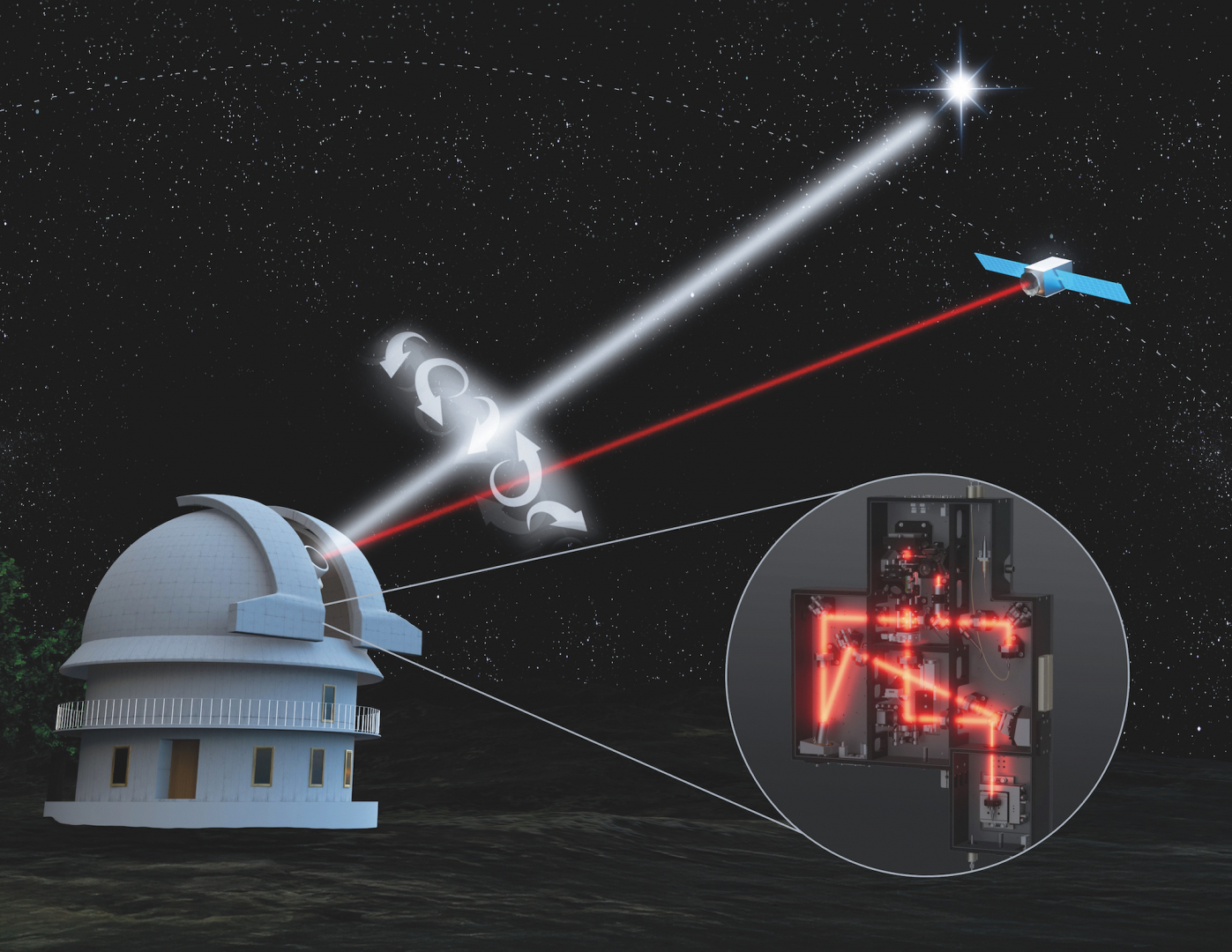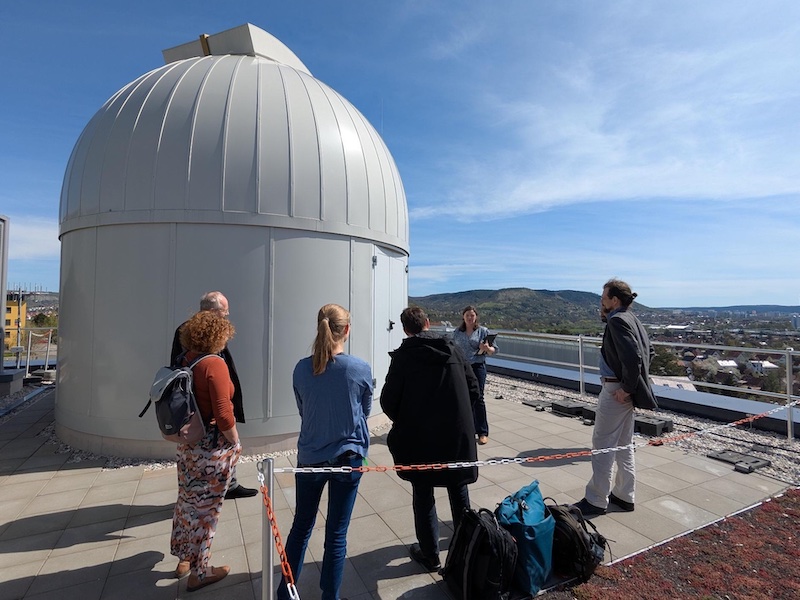The Thuringian State Observatory in Tautenburg and the Fraunhofer Institute for Applied Optics and Precision Engineering IOF in Jena are jointly developing a key technology that can be used for astronomical measurements of stars and in modern devices for transmitting encrypted data. The FREEFIB research group is focusing on the development of compact adaptive optics for the efficient feeding of light into a single-mode fiber optic cable.
Anyone who has looked up at the starry sky on a clear night is familiar with the phenomenon: the stars twinkle. This twinkling is not caused by the stars themselves, but by air turbulence in the Earth's atmosphere. Layers of air with different temperatures are mixed together, creating turbulence.
This effect, known in astronomy as “seeing,” reduces the resolving power of telescopes — even at the best locations for astronomical observations. As a result, stars, which are actually perfect point sources of light, are imaged by telescopes as blurred spots.
This, in turn, means that instruments for spectroscopic analysis of starlight must be built correspondingly larger (and thus also more expensive) – or a large portion of the light captured by the telescope is lost. If it were possible to avoid the negative effect of “seeing,” spectrographs for detailed studies of stars could be built much more compactly.
Correcting light distortion with adaptive optics
 Atmospheric turbulence causes wavefront distortions, which are problematic for astronomical observations, for example. A compact module with adaptive optics (enlarged on the right) is designed to help correct the effects of atmospheric turbulence. Illustration: Fraunhofer IOFCorrecting seeing is technically possible. It can be achieved using what is known as adaptive optics. This is a technology that can largely correct the distortions in starlight caused by atmospheric turbulence. Adaptive optics has been used successfully for around 20 years on large telescopes in the eight-meter class. However, it is not yet widely used on smaller telescopes due to its cost and complexity.
Atmospheric turbulence causes wavefront distortions, which are problematic for astronomical observations, for example. A compact module with adaptive optics (enlarged on the right) is designed to help correct the effects of atmospheric turbulence. Illustration: Fraunhofer IOFCorrecting seeing is technically possible. It can be achieved using what is known as adaptive optics. This is a technology that can largely correct the distortions in starlight caused by atmospheric turbulence. Adaptive optics has been used successfully for around 20 years on large telescopes in the eight-meter class. However, it is not yet widely used on smaller telescopes due to its cost and complexity.
The Thuringia State Observatory and Fraunhofer IOF want to change that. Their FREEFIB research group works on a solution for coupling a laser beam, which is transmitted through the air via a free beam on an optical line-of-sight connection, back into an optical fiber, specifically a single-mode fiber. The goal is to develop a compact and cost-efficient module for fiber coupling of starlight or laser light for telescopes in the one- to two-meter class. The name FREEFIB is a combination of the free beam of light, or “free space,” which is directed into a fiber.
Reducing signal loss between ground stations and satellites
 Members of the FREEFIB research group on the roof of the Fraunhofer IOF in Jena. Aoife Brady (fifth from left) explains the function of the optical ground station. The dome houses a fast-moving telescope for optical communication with satellites. Photo: TLSFraunhofer IOF is a pioneer in applied research on laser communication and quantum encryption. Similar to telescopes in astronomical research, atmospheric turbulence causes high signal losses between optical ground stations and satellites in laser-based signal transmission. The solution here, too, is adaptive optics.
Members of the FREEFIB research group on the roof of the Fraunhofer IOF in Jena. Aoife Brady (fifth from left) explains the function of the optical ground station. The dome houses a fast-moving telescope for optical communication with satellites. Photo: TLSFraunhofer IOF is a pioneer in applied research on laser communication and quantum encryption. Similar to telescopes in astronomical research, atmospheric turbulence causes high signal losses between optical ground stations and satellites in laser-based signal transmission. The solution here, too, is adaptive optics.
The Thuringian State Observatory is planning to build an ultra-high-resolution spectrograph for long-term asteroseismic studies of bright stars. In both applications, it is necessary for the light received by the telescope to be fed into a thin glass fiber (single-mode glass fiber) so that it can be transmitted to an analysis device. This is referred to as fiber coupling.
Professor Dr. Markus Roth, director of the Thuringian State Observatory, is delighted about the collaboration with the Fraunhofer Institute for Applied Optics and Precision Engineering IOF: "The FREEFIB research group brings together two partners who want to tackle a similar technical challenge. It is a huge advantage that there is such a large network of optics specialists in Jena. This facilitates cooperation. Both research institutes will benefit from the results."
"TLS Tautenburg and Fraunhofer IOF Jena are continuing their successful cooperation in the FREEFIB research group. The expertise of both institutes makes it possible to adapt single-mode fiber coupling technology for larger telescopes. The challenge is to simplify adaptive optics and thus also address new applications beyond communication and spectroscopy,“ says Dr. Ramona Eberhardt, deputy director at Fraunhofer IOF.
FREEFIB continues until December 2027. The research is financed by the Free State of Thuringia with funding from the European Social Fund (ESF) Plus.

